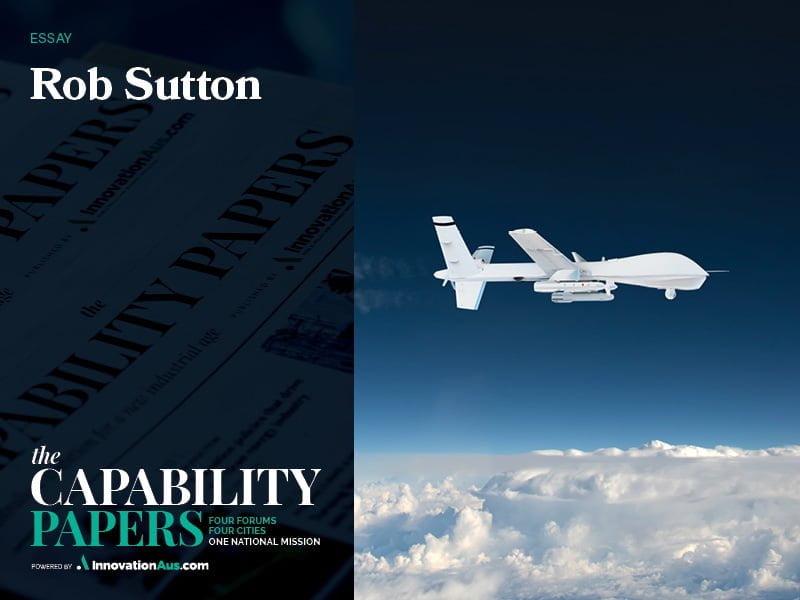Robotics and Autonomous Systems (RAS) have become increasingly important in many sectors, including defence, mining and manufacturing. Indeed, Australia is a leader in the use of RAS in mining, and we have a nascent drone ecosystem that is poised for growth. Building a sovereign RAS industry is within Australia’s reach, but it needs support.
While RAS technology is high-tech, it is not complex, and Australia has the capacity to build up a large domestic industry. The development and deployment of RAS technology is already being used to improve productivity in business, and its use in warfare, is an inevitable reality. Australia must ensure that it is prepared to take advantage of it.

Productivity growth is key to national prosperity
The 2023 Productivity Commission report states that in the decade to 2020, average annual productivity growth in Australia was the lowest in 60 years, falling to just 1.1 per cent. In terms of global performance, Australia ranked 6th in the OECD in 1970, but this had dropped to 16th in 2020. Australia’s productivity is now 22 per cent lower than the United States. Higher productivity growth has given us better living standards and more leisure time. Failing to address falling productivity puts this at risk. The Productivity Commission report highlights that the creation of an innovation ecosystem, and a more diverse economy, are keys to unlocking productivity growth.
National security is another aspect of national prosperity. The 2023 Defence Strategic Review highlights that Australia’s prosperity is fundamentally linked to the rules-based order on which international trade depends. Without security, there is no prosperity.
RAS is essential for national defence, and it can improve productivity
Robotics and Autonomous Systems (RAS) are key to productivity growth, national security, and national prosperity. RAS have the potential to generate enormous social, economic and environmental benefits for Australia. They are currently used in the Australian mining, agriculture and construction sectors to improve efficiency and, crucially, to enhance safety.
RAS are distinct from other major Defence capabilities. Whilst RAS can be ships, vehicles or planes, they are not as complex as crewed platforms. Given there is no person on board, the safety requirements are not as high. This means that RAS can be simpler. Capabilities can also be disaggregated because RAS platforms are connected by a network. Separate functions can be performed by separate platforms, negating the need for a single, expensive platform. As a result, RAS technology can evolve rapidly, and the threshold for designing and implementing these systems is much lower.
RAS can also perform a wide variety of functions, not only in Defence but across any sector that uses crewed platforms, such as mining, manufacturing, agriculture and transport. The individual components and capabilities that are used in the construction of RAS capabilities span a breadth of expertise and domains. These include AI, computer vision, sensors, advanced materials, batteries, satellite positioning and navigation, and advanced communications. Good investment in RAS platforms ensures that a robust ecosystem will emerge to support each of these functions and components. Additionally, there will be a need to have a breadth of skills to support our RAS future. These skills can be developed across the full spectrum of our education system, including our world-class TAFE system and universities. Science, technology, engineering and mathematics (STEM) skills will be fundamental in many of these roles. Therefore, development of a robust, and sovereign, RAS ecosystem will develop the STEM skills which are essential for the rest of our economy.
Supporting a sovereign RAS industry
Defence should prioritise the development of smaller, tactical capabilities, like RAS, as true sovereign capability. RAS involves lower financial risks and shorter innovation timelines. This makes it feasible to domestically design and manufacture these technologies to meet our specific requirements. Investment by Defence in a sovereign RAS ecosystem will support a thriving commercial RAS ecosystem.
Nurturing a sovereign RAS industry is within Australia’s reach. However, it requires support, particularly from the government and Defence. This support starts with the simplification and integration of the Defence innovation and procurement process. A programmatic approach to procurement should be adopted. This will avoid the pitfalls associated with the current Defence procurement approach of sporadic, platform-based procurements.
A programmatic approach shifts the focus from the procurement of specific platforms to the generation of platform-agnostic effects. It involves considering enablers that are necessary for achieving effective capabilities. Such enablers that should be considered include common training, test facilities, or generic data architectures. A programmatic approach supports consistent funding and the progression of technologies to higher readiness levels.
To ensure its growth and sustainability, Defence must invest in RAS technology R&D, while providing clear and consistent funding priorities. This will provide industry stakeholders with the necessary assurance that investment in advanced technology, workforce development and scale proven concepts, is commercially viable. It will allow sovereign industry to deliver impactful capabilities to end-users and bridge the ‘valley of death’.
Initiatives like the Advanced Strategic Capabilities Accelerator (ASCA) represent steps in the right direction. However, to obtain the most value, the ASCA should transcend traditional risk-averse and transactional practices and prioritise investment in cultivating a world-leading knowledge and skills-based industry. The projected value of the global market for Defence Robotics over the next decade is $50 billion, promising long-term dividends for forward-looking RAS investments.
Conclusion
True sovereign capability is achieved through Australian sovereign industry. Australia’s capacity to design, build, and manufacture RAS domestically will support productivity growth, national security, and national prosperity. Investment in research and development of RAS capabilities will nurture a thriving RAS sector in Australia, which will stimulate innovation and technological advancements. A robust RAS industry attracts investment, fosters job creation, and advances a more skilled STEM workforce, increasing their capacity for more complex capabilities.
Rob Sutton is an aviation engineer, formerly with the Australian Army and now helping organisations maximise the potential of drone technology. His vision is to transform the way organisations utilise drones to optimise their operations, enhance safety, and drive innovation across a range of industries. Rob and his team work with clients in the defence, government, mining, and agriculture sectors to fully implement drone tech.
Do you know more? Contact James Riley via Email.

